Warts and Verrucas
Home » Conditions » Warts and Verrucas
Wart-free skin awaits!
Not sure about your condition? Get in touch now, there is no reason for you to wait.
Award winning dermatology service, with over 20 years of experience
Short waiting lists, on some occasions offering same week appointments
Safe environment, in Care Quality Commission approved facilities
Verrucae Treatment and wart removal In London.
Warts and verrucas are one of the most common skin problems in the UK. Most people will have a wart or verruca at some point in their lives. Although these small growths are usually harmless, they can be unsightly or uncomfortable if they are in the wrong place. Treatments are available that can remove your warts and verrucas in various ways.
WHAT ARE WARTS AND VERRUCAE?
Warts are caused by the human papilloma virus, which enters the skin surface, causing growth and thickening of the top (epidermal) layer of the skin. This produces the rough, hard texture of a wart. The strain of HPV that causes warts and verrucas is different from the ones that are linked to cervical cancer, so you can get a wart or verruca even if you have had the HPV vaccine.
Verrucas are simply warts that have formed on the sole of the foot. Since they are under pressure from the foot, verrucas are usually flatter than warts. Verrucas are also more likely to feel painful, because of this pressure.
Warts are contagious, and close skin-to-skin contact can pass on the infection. The risk of infection is increased if the skin is damaged or wet and in contact with roughened surfaces, for example, in communal swimming pools. If you want to swim then it is best to cover warts and verrucas with waterproof plasters in order to prevent them from spreading to other people. You should also avoid sharing towels, socks or shoes as these could carry the virus if they have been in contact with warts or verrucas.
The virus that causes warts and verrucas can also spread to other parts of your own skin. This is why people often end up with a cluster of growths in one area. You should try to avoid scratching or picking at a wart or verruca as this could move the virus around, enabling it to create new growths.
After becoming infected, it can take several weeks for a wart or verruca to appear. The immune system can sometimes get rid of warts and verrucas by itself, but this process could take months or even years. Most people will therefore want to seek treatment for warts and verrucas in order to get rid of them more quickly.
Most people will have warts at some point in their life, though they tend to affect children and young adults. Warts are generally not painful, though verrucas can be sore to stand on. Some people find their warts embarrassing and those on the fingers may interfere with normal daily activities. Without treatment, the length of time it takes a wart to disappear will vary between people. As a rough guide, about a third of warts have gone within three months, and most will have resolved within 2 years. Verrucas can take a lot longer than this to disappear.
WHAT DO WARTS AND VERRUCAE LOOK LIKE?
Warts appear most often on the hands and feet, though they can spread to other parts of the body, for example around the nails, lips and genitals. Verrucas are warts that develop on the soles of the feet. Warts vary in appearance depending on where they are on the body and how thick the skin is but the common wart is often round, firm and raised, with a rough or ‘warty’ surface (see pictures). On close inspection, many tiny black dots may be seen in the centre, caused by ruptured blood vessels. These ruptured blood vessels are more likely to be seen on verrucas, because they have been compressed underneath the foot.
Warts and verrucas can be classified into several different types based on how they look:
- Common wart: a round, raised growth with a rough surface that is sometimes compared to the texture of a cauliflower. These types of warts are usually seen on the hands and can grow up to 1cm across, although most are just a few millimetres in diameter.
- Plantar wart or verruca: a wart on the sole of the feet that usually looks flattened and has tiny black dots in it where the blood vessels have burst. Clusters of verrucas can sometimes join together to form mosaic warts.
- Flat or plane wart: a smooth, round growth that can be flat or slightly raised. These types of wart often appear on the face, neck, legs or the backs of the hands. Sometimes they form large clusters of tend or even hundreds of warts.
If you notice any unusual growths or patches on your skin then it is always best to get them checked by an expert. Although it is probably just a wart or verruca, there is a small chance that a growth could be something more serious such as a skin cancer.
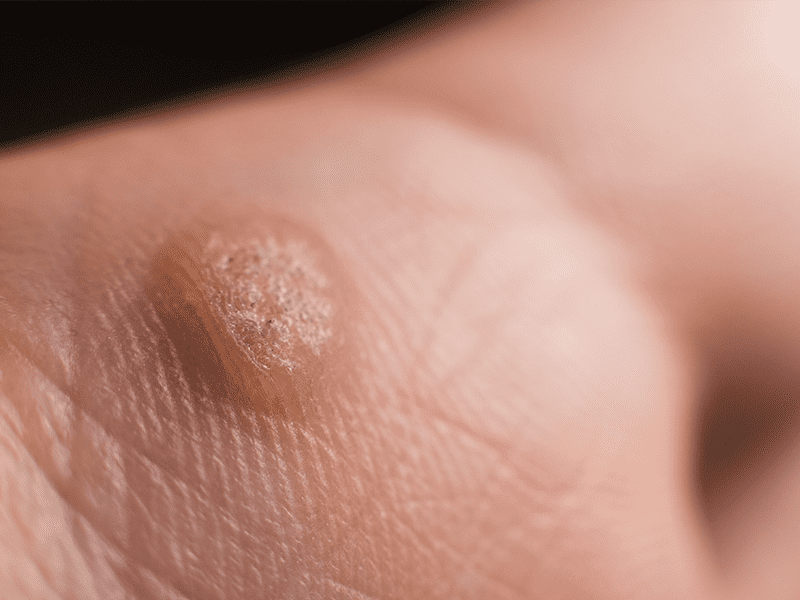
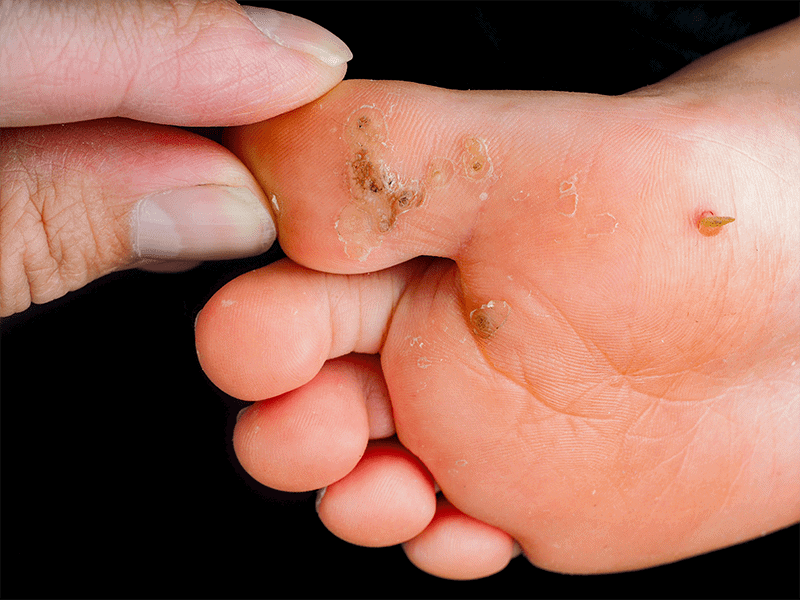
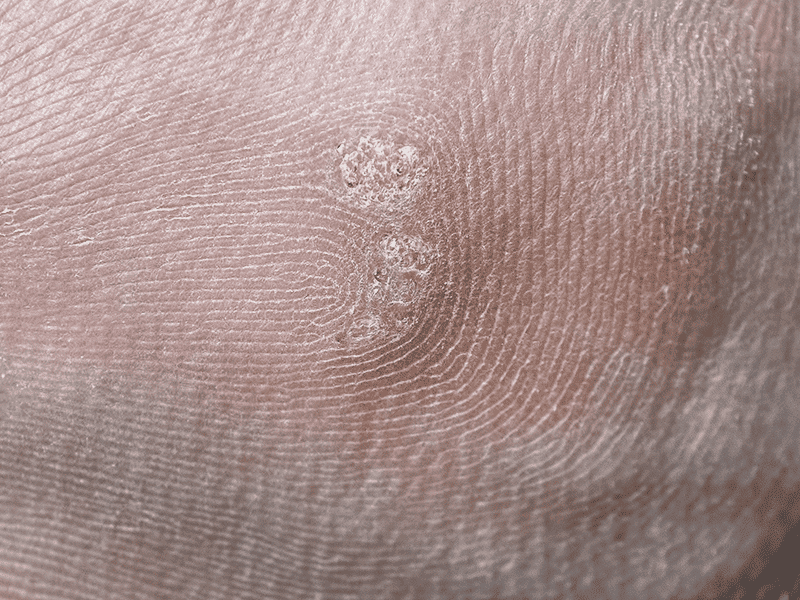
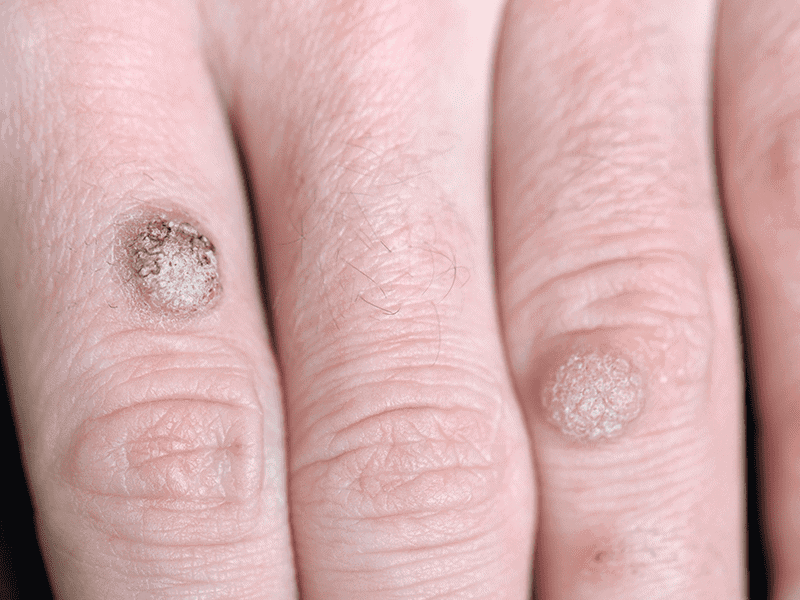
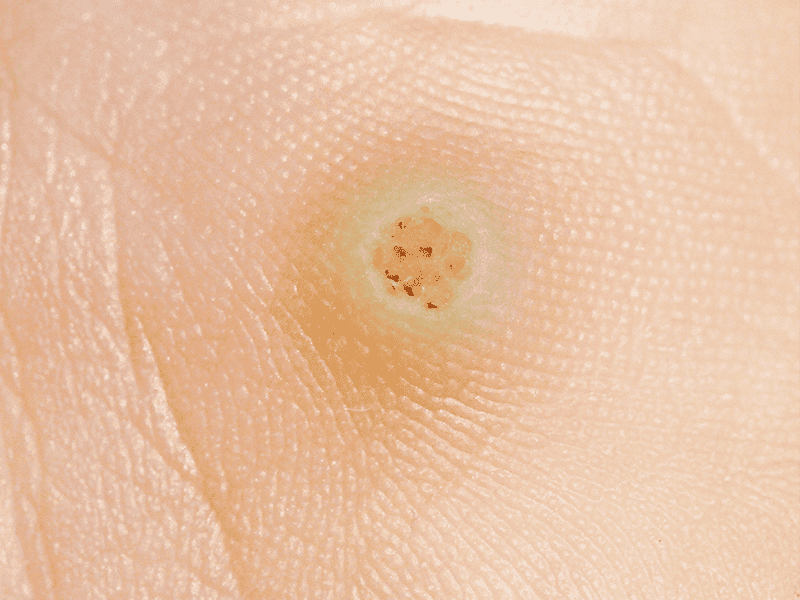
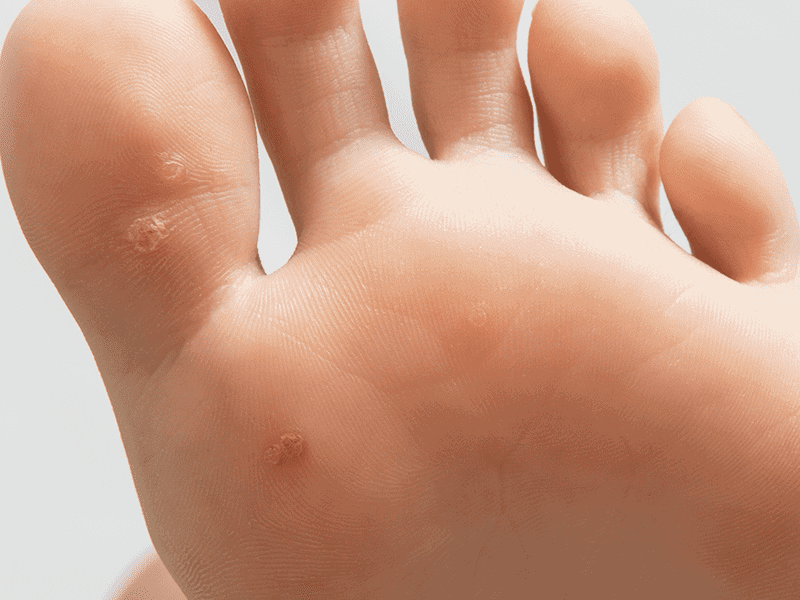
HOW CAN WARTS & VERRUCAE BE TREATED?
Warts and Verrucae can be diagnosed simply by looking at the affected parts of your skin. Warts are usually harmless and heal by themselves, however, treatment can speed this process up. Treatment options include:
- Chemical treatments (salicylic acid or formaldehyde preparations depending on the type of wart)
- Cryotherapy (freezing the skin cells with liquid nitrogen)
- Wart Removal under local anaesthetic
- Treatment with diphencyprone (this is painted onto the warts every 2-4 weeks and provokes an allergic reaction which boosts the natural immune response against the wart virus.)
Treatment for warts are not always effective first time, and a wart can sometimes recur. However, your dermatologist will be able to recommend the best treatment options for you.
New to the Harley Street Dermatology Clinic is a treatment for difficult warts with immune therapy – Diphencyprone (DCP). When DCP is applied to the skin, it boosts the immune response in the skin and this helps to clear the virus responsible for causing warts and verrucas. 80-90% of patients with warts will respond to treatment with DCP. If your warts have not responded to standard therapies, there is a good chance they may be cleared with DCP therapy.
Our Specialist Dermatologists at the Harley Street Dermatology Clinic can offer effective treatment to help cure or control viral warts.
FREQUENTLY ASKED QUESTIONS
WHAT IS THE DIFFERENCE BETWEEN A WART AND VERRUCAE?
Warts and verrucas are growths caused by the same virus on different parts of the skin. Warts can appear anywhere on the body, although they are most common on the hands. Verrucas are warts that form on the soles of the feet. Since verrucas are squashed under the foot, they can look a bit different from other warts. Verrucas are usually flattened and often have dark specks as a result of tiny blood vessels being crushed inside them. The same kinds of treatments can be used on warts and verrucas.
ARE WARTS AND VERRUCA CONTAGIOUS?
Warts and verrucas are caused by a virus that can spread from one person to another. The chances of this happening are generally low, but it is more likely if the skin is wet or damaged. It’s therefore important to take precautions to prevent this such as wearing waterproof plasters while swimming or not sharing towels. The virus can also spread from one part of your skin to another, so you should try to avoid scratching or picking at the affected areas. It is also best to keep the skin dry as much as possible, so make sure that you are drying yourself thoroughly after baths or showers. You should also avoid sharing your towels with other people to avoid spreading the virus to them.
HOW DO YOU CATCH WARTS AND VERRUCAS?
Warts and verrucas happen when a strain of the Human Papilloma Virus (HPV) gets into the outer later of the skin. The infection causes the skin to thicken, creating a small growth known as a wart or verruca. Viruses like HPV can’t usually get into the skin, but it can happen when the outer layer of skin is wet or damaged. This is why warts and verrucas often spread at public swimming pools, where people are touching the same surfaces with wet skin.
HOW COMMON ARE WARTS AND VERRUCAS?
Warts and verrucas are so common that most people will have them at some point in their lives. Some people are more likely to catch the virus that causes warts and verrucas, especially if they have a condition or are taking medication that weakens their immune system. Children are also more likely to be affected. This is because they have less developed immune systems and are more likely to spend time swimming or in close contact with each other while playing. Approximately 1 in 10 children will be affected by warts of verrucas.
ARE GENITAL WARTS THE SAME AS OTHER WARTS?
Genital warts are similar to the warts and verrucas that appear on other parts of your skin, but they are caused by a different strain of HPV that can’t affect other areas. Genital warts are considered a sexually transmitted infection (STI) because they can be spread through sexual contact. If you have warts in the genital area then it is important to see your GP or visit a sexual health clinic as they will require a different type of treatment than other kind of warts.
DO I NEED TO GET TREATMENT FOR WARTS AND VERRUCAS?
Warts and verrucas are generally harmless. In time, they will often go away by themselves, but this could take more than a year. If you’re unsure whether a growth is definitely a wart, you’re uncomfortable or embarrassed about it, or you just don’t want to wait for it to disappear, then you should seek treatment. The wart or verruca can be removed.
WHAT HAPPENS IF WART AND VERRUCA TREATMENT DOESN'T WORK?
Getting rid of warts and verrucas can be tricky. You might have tried over the counter wart and verruca removal products without any success before seeing a doctor or the treatment your dermatologist provided might not have worked at first. Sometimes it takes a while to find the treatment that will work for you. Your dermatologist can offer a number of different wart treatments, so if one of them doesn’t work there will usually be another option to try. For example, diphencyprone or DCP therapy is a new treatment for warts and verrucas that can be particularly effective when they haven’t responded to the other options.
CAN A WART OR VERRUCAE LEAVE A SCAR?
Warts and verrucas only affect the outer layer of the skin so they shouldn’t cause any deeper damage. Once the wart or verruca has gone away or been removed, there shouldn’t be any sign that it was there.
CAN A WART OR VERRUCA BE HARMFUL?
Warts or verrucas won’t cause any serious complications, but they can be a bit painful or uncomfortable. You might also feel self-conscious about them if they are in a visible place. However, there is a small chance that you might mistake another type of growth for a wart or verruca, so it is best to get them checked by an expert just in case. You can see a dermatologist for treatment or ask a pharmacist to confirm that you have a wart or verruca.
WHAT ELSE COULD A GROWTH ON MY SKIN BE?
If you have a growth that looks like a wart or verruca, then that is the most likely diagnosis. Another possibility is that the growth is a corn, which is a small and harmless growth that can appear where skin has been under pressure (for example where your shoe has been rubbing). There are also some types of skin cancer that can look similar to warts so it is important to consult an expert if you’re not sure what it is. It is especially important to see a doctor if the growth is painful, itchy, growing quickly or bleeding. Although it could still be a wart or another benign growth, there is a chance it could be something more serious that require immediate treatment.
HEAR FROM OUR PATIENTS
Start Your Journey With Us
Please fill in this form and one of our team will give you a call back to arrange a consultation with one of our expert dermatologists.
WHY TREAT YOUR WARTS & VERRUCAE AT THE HARLEY STREET DERMATOLOGY CLINIC?
Having the right dermatologist is important especially when you have a chronic skin condition that will require ongoing treatment. We want you to feel confident that we’re providing you with the best possible care. We also want you to feel as comfortable as possible with your dermatologist.
The Harley Street Dermatology Clinic specialises in conditions affecting the skin, hair and nails. Our goal is to provide all the care that you need when you’re experiencing these kinds of problems. We want to make it easy for you to access the best quality treatment and support for your wart removal London.
The clinic is conveniently located in Central London, so it’s easy to visit us if you need to see a dermatologist. You will find yourself in a very comfortable and welcoming environment. We have created a relaxing space where you will receive the highest quality of care. We are regulated by the Care Quality Commission, are part of the British Association of Dermatologists and are top rated by patients of Doctify so you can be sure of safe and effective treatment with us.
Warts & Verrucae Treatment Process:
Book Assessment
Contact us to arrange a no-obligation consultation with our experienced specialist who will examine and discuss your stage of warts & verrucae.
Appropriate Treatment Identified
There are a wide range of treatment options available depending on the severity and location of your warts and/or verrucae. Our experienced dermatologist will explain all of your treatment options and help you to decide the best programme for you.
Treatment Begins
Once an appropriate treatment has been agreed upon, the treatment programme begins, and you’ll be well on your way to a healthier, happier skin. Results will likely appear within the timeframe suggested by your warts and verrucae specialist.
Latest INSIGHTS AND ADVICE

Winter Skin Conditions
Winter weather can take a heavy toll on our skin. We are constantly stepping between the warm, heated rooms indoors and the cold, dry air outside. We also tend to wrap up more at this time of year, which can cause problems if clothes are

Should You Worry About Sun Damage in Winter?
Sun damage isn’t usually a problem in the UK in winter. The UV rays are not usually strong enough at this time of year to cause sunburn, but they can still affect your skin. Sun damage is responsible for many of the skin conditions treated

Are The Effects of Skin Conditions Underestimated?
Skin conditions can be embarrassing, uncomfortable and tricky to treat, but they are often dismissed as minor or cosmetic problems. It’s time we all took our skin more seriously.







